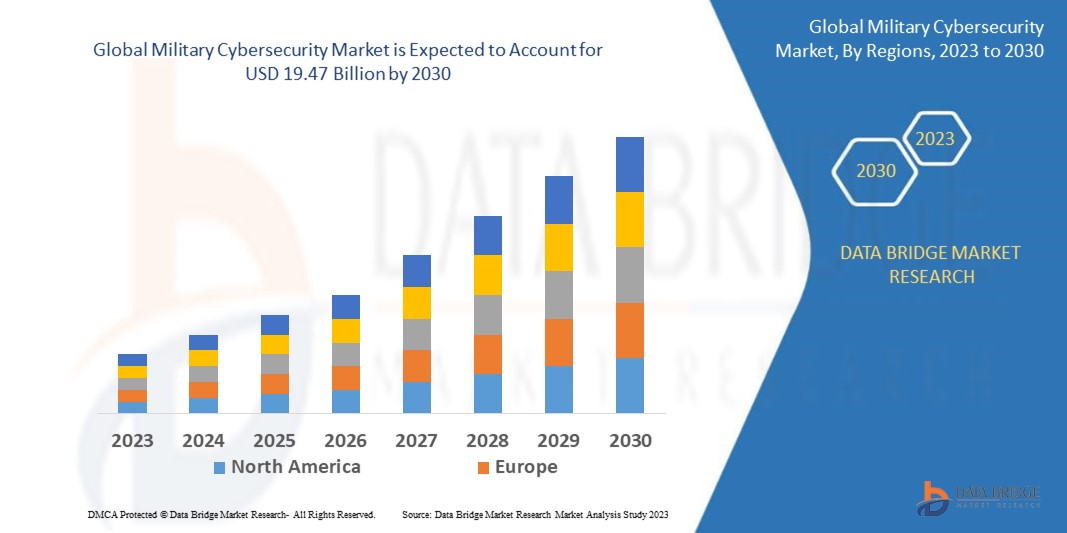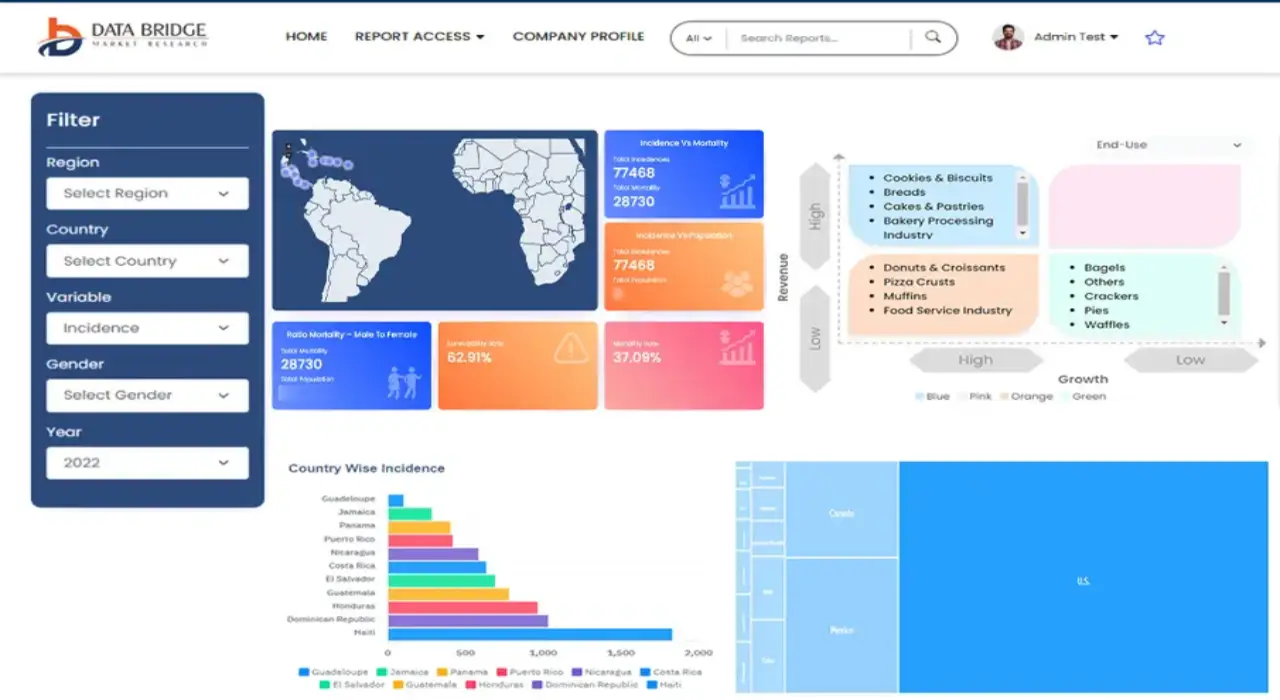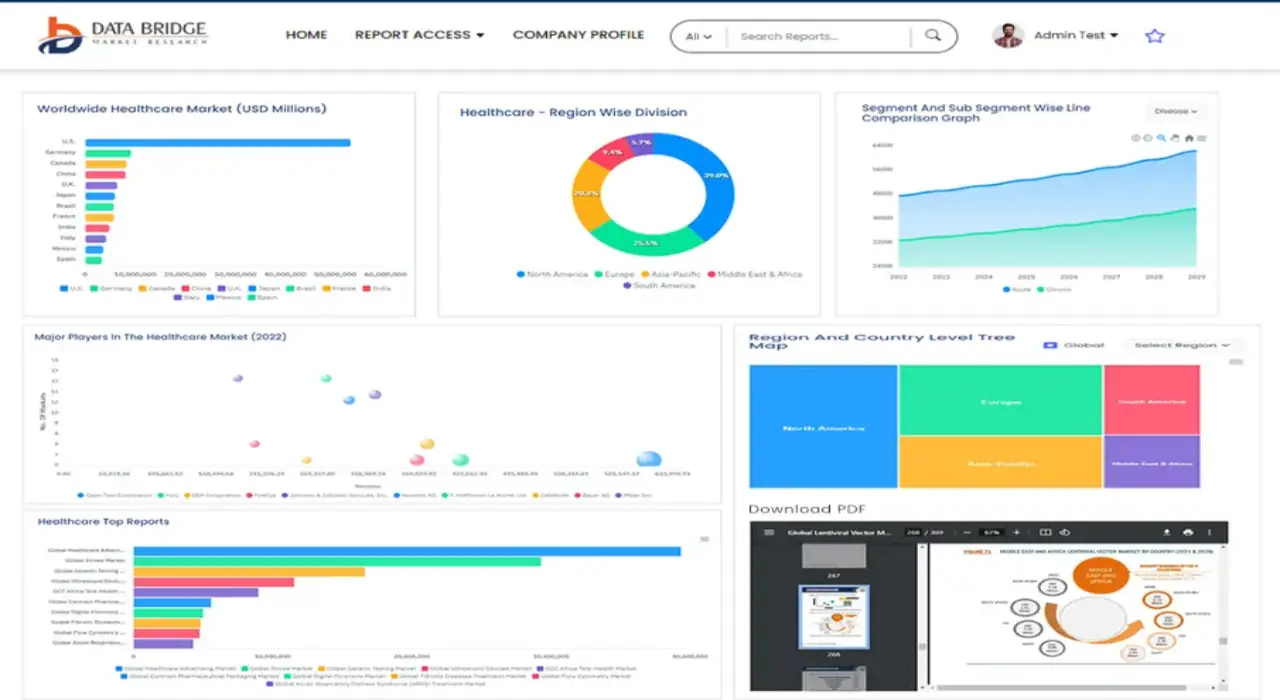Global Military Cybersecurity Market
시장 규모 (USD 10억)
연평균 성장률 :
% 
| 2023 –2030 | |
| USD 10.51 Billion | |
| USD 19.47 Billion | |
|
|
|
>글로벌 군사 사이버 보안 시장, 플랫폼(하드웨어, 서비스, 솔루션), 유형( 네트워크 보안 , 사이버 위협 인텔리전스, IT 인프라, 물류 및 운영 보안, 교육 서비스, ID 및 액세스 보안, 데이터 보안, 클라우드 보안), 솔루션(위협 인텔리전스 및 대응 관리, ID 및 액세스 관리, 데이터 손실 방지 관리, 보안 및 취약성 관리, 통합 위협 관리, 기업 위험 및 규정 준수, 관리형 보안, 기타), 배포 모드(클라우드, 온프레미스), 애플리케이션(육군, 해군, 공군) - 업계 동향 및 2030년까지의 예측.
군사 사이버 보안 시장 분석 및 규모
클라우드 기반 스토리지 솔루션 채택률이 높으면 군사 사이버 보안 시장 확대에 영향을 미칠 것으로 예상됩니다. 또한, 다양한 정부가 사이버 공격 위협에 대처하고 더 나은 수준의 보안 솔루션을 보장하기 위해 투자가 증가함에 따라 군사 사이버 보안 시장도 혜택을 볼 것으로 예상됩니다. 또한, 빠른 기술 발전으로 무인 차량에 대한 접근성이 높아짐에 따라 이러한 제품이 해킹에 덜 취약하도록 보장하기 위해 더 나은 주변 장치와 보안 서비스가 필요합니다.
Data Bridge Market Research는 2022년에 105억 1,000만 달러 규모였던 군사 사이버 보안 시장이 2030년에는 194억 7,000만 달러에 도달할 것으로 분석하며, 2023년부터 2030년까지의 예측 기간 동안 연평균 성장률 8.01%로 성장할 것이라고 밝혔습니다. Data Bridge Market Research 팀이 큐레이팅한 시장 보고서에는 시장 가치, 성장률, 시장 세그먼트, 지리적 범위, 시장 참여자, 시장 시나리오와 같은 시장 통찰력 외에도 심층적인 전문가 분석, 수입/수출 분석, 가격 분석, 생산 소비 분석, 페슬 분석이 포함되어 있습니다.
군사 사이버 보안 시장 범위 및 세분화
|
보고서 메트릭 |
세부 |
|
예측 기간 |
2023년부터 2030년까지 |
|
기준 연도 |
2022 |
|
역사적 연도 |
2021 (2015-2020까지 사용자 정의 가능) |
|
양적 단위 |
매출은 10억 달러, 볼륨은 단위, 가격은 10억 달러 |
|
다루는 세그먼트 |
플랫폼(하드웨어, 서비스, 솔루션), 유형(네트워크 보안, 사이버 위협 인텔리전스, IT 인프라, 물류 및 운영 보안, 교육 서비스, ID 및 액세스 보안, 데이터 보안, 클라우드 보안), 솔루션(위협 인텔리전스 및 대응 관리, ID 및 액세스 관리, 데이터 손실 방지 관리, 보안 및 취약성 관리, 통합 위협 관리, 엔터프라이즈 위험 및 규정 준수, 관리형 보안, 기타), 배포 모드(클라우드, 온프레미스), 애플리케이션(육군, 해군, 공군) |
|
적용 국가 |
U.S., Canada and Mexico in North America, Germany, France, U.K., Netherlands, Switzerland, Belgium, Russia, Italy, Spain, Turkey, Rest of Europe in Europe, China, Japan, India, South Korea, Singapore, Malaysia, Australia, Thailand, Indonesia, Philippines, Rest of Asia-Pacific (APAC) in the Asia-Pacific (APAC), Saudi Arabia, U.A.E, South Africa, Egypt, Israel, Rest of Middle East and Africa (MEA) as a part of Middle East and Africa (MEA), Brazil, Argentina and Rest of South America as part of South America. |
|
Market Players Covered |
Qualcomm Technologies, Inc. (U.S.), Microsoft (U.S.), Oracle (U.S.), Cisco Systems, Inc. (U.S.), Northrop Grumman. (U.S.), Accenture (Ireland), IBM (U.S.), Thales (France), Lockheed Martin Corporation. (U.S.), General Dynamics Corporation (U.S.), BAE Systems (U.K.), Raytheon Technologies Corporation (U.S.), Airbus (France), Leonardo S.p.A. (Italy), NETCENTRICS CORPORATION (U.S.), Fujitsu (Japan), CyberArk Software Ltd. (U.S.), Booz Allen Hamilton Inc. (U.S.), Check Point Software Technologies Ltd (Israel), Rapid7 (U.S.), Fortinet, Inc. (U.S.) |
|
Market Opportunities |
|
Market Definition
Military cybersecurity refers to the practice of protecting military organizations, assets, and operations from cyber threats and attacks. It involves the implementation of strategies, technologies, and processes to safeguard military networks, systems, and data from unauthorized access, disruption, and compromise. Military cybersecurity aims to ensure the confidentiality, integrity, and availability of critical information, as well as to maintain the functionality and operational readiness of military systems. It involves measures such as network security, encryption, access controls, incident response, and threat intelligence to mitigate cyber risks and maintain national security.
Military Cybersecurity Market Dynamics
Drivers
- Increasing cyber threats can drive the market
As technology advances, cyber threats against military organizations have grown more sophisticated and widespread. These attacks can compromise sensitive information, disrupt operations, and target critical infrastructure. Consequently, there is an increasing demand for strong cybersecurity solutions to safeguard military networks, systems, and data from these evolving threats. The urgency to protect military assets drives the need for robust cybersecurity measures in the face of the escalating threat landscape.
- Growing adoption of network-centric warfare can drive the market
The growing adoption of network-centric warfare by military forces emphasizes the critical role of information and communication systems in coordinating operations. However, this reliance on interconnected networks and data sharing introduces new vulnerabilities and potential cyber threats. Robust cybersecurity measures are essential to protect military assets, ensure mission success, and maintain operational effectiveness. By safeguarding against potential cyberattacks, military organizations can mitigate risks and maintain the integrity of their network-centric warfare strategies.
Opportunities
- Collaboration with the private sector creates lucrative opportunities to grow
Collaboration with the private sector presents a significant opportunity for military organizations in the realm of cybersecurity. Partnering with cybersecurity companies, research institutions, and technology vendors allows military organizations to tap into the expertise and innovative solutions developed by these entities. This collaboration enables the adoption of advanced technologies and best practices, enhancing the effectiveness of military cybersecurity measures and bolstering defenses against evolving cyber threats. It fosters knowledge exchange, access to cutting-edge solutions, and the potential for tailored cybersecurity capabilities to meet specific military requirements.
- Public awareness and high-profile cyber incidents create market opportunities
The rising public awareness of cybersecurity risks, coupled with high-profile cyber incidents targeting military organizations, creates a demand for enhanced cybersecurity capabilities. These incidents underscore the potential consequences of cyberattacks on national security and public safety. As a result, there is a growing recognition of the need for proactive cybersecurity measures to protect military assets, critical infrastructure, and sensitive information. The focus on improving cybersecurity is driven by the imperative to mitigate risks and safeguard vital military resources and operations.
Restraints/Challenges
- Regulatory and compliance issues can limit the market growth
Military organizations are subject to a multitude of cybersecurity regulations and standards, which can vary across different jurisdictions. Achieving compliance with these requirements can be challenging, time-consuming, and resource-intensive. The focus on meeting regulatory and compliance obligations may divert attention and resources away from other critical cybersecurity initiatives, potentially affecting the overall effectiveness of military cybersecurity measures. Balancing compliance efforts with proactive cybersecurity strategies is essential to ensure comprehensive protection against evolving cyber threats.
- Budget constraints can limit market growth
Budget constraints pose a significant challenge to military cybersecurity efforts. Limited resources make it difficult for military organizations to allocate adequate funding for cybersecurity technologies, personnel, training, and maintenance. This can result in the inability to implement comprehensive cybersecurity measures, leaving vulnerabilities that cyber attackers can exploit. Balancing competing priorities and securing sufficient budgetary support is crucial for ensuring effective cybersecurity and safeguarding military systems and data from cyber threats.
This military cybersecurity market report provides details of new recent developments, trade regulations, import-export analysis, production analysis, value chain optimization, market share, impact of domestic and localized market players, analyses opportunities in terms of emerging revenue pockets, changes in market regulations, strategic market growth analysis, market size, category market growths, application niches and dominance, product approvals, product launches, geographic expansions, technological innovations in the market. To gain more info on the military cybersecurity market contact Data Bridge Market Research for an Analyst Brief, our team will help you take an informed market decision to achieve market growth.
Recent Developments
- In 2023, In order to support the cybersecurity of the organization, IBM Belgium and King ICT Croatia have signed contracts with NATO. The integration of cyber defense capabilities and related configuration services will be covered by these contracts, which are worth USD 31.7 million, from February until 2025 with an additional two-year option.
- In 2022, As the United States transforms into a data-centric force, the United States Army declared that they want to implement a zero-trust cybersecurity framework. Additionally, the United States Army's Project Convergence experiment saw Raytheon Intelligence and Space showcase its Operational Zero Trust platform.
- In 2019, The Department of Defense Information Network (DoDIN-A) will receive mission support from the General Dynamics Corporation through the Army's Cybersecurity and Network Operations Mission Support program (ADCNOMS) under a contract worth USD 118 million signed with the U.S. Army.
Global Military Cybersecurity Market Scope
The military cybersecurity market is segmented on the basis of platform, type, solution, deployment type, application. The growth amongst these segments will help you analyze meagre growth segments in the industries and provide the users with a valuable market overview and market insights to help them make strategic decisions for identifying core market applications.
Platform
- Hardware
- Service
- Solution
Type
- Network Security
- Cyber Threat Intelligence
- IT Infrastructure
- Logistics and Operations Security
- Training Services
- Identity and Access Security
- Data Security
- Cloud Security
Solution
- Threat Intelligence and Response Management
- Identity and Access Management
- Data Loss Prevention Management
- 보안 및 취약성 관리
- 통합 위협 관리
- 기업 위험 및 규정 준수
- 관리되는 보안
- 기타
배포 모드
- 구름
- 온프레미스
애플리케이션
- 군대
- 해군
- 공군
군사 사이버 보안 시장 지역 분석/통찰력
군사 사이버보안 시장을 분석하고, 위에 언급된 대로 플랫폼, 유형, 솔루션, 배포 유형, 애플리케이션별로 시장 규모에 대한 통찰력과 추세를 제공합니다.
군사 사이버 보안 시장 보고서에서 다루는 국가는 다음과 같습니다. 북미의 미국, 캐나다 및 멕시코, 유럽의 독일, 프랑스, 영국, 네덜란드, 스위스, 벨기에, 러시아, 이탈리아, 스페인, 터키, 유럽의 기타 유럽 국가, 중국, 일본, 인도, 한국, 싱가포르, 말레이시아, 호주, 태국, 인도네시아, 필리핀, 아시아 태평양(APAC)의 기타 아시아 태평양 국가(APAC), 사우디 아라비아, UAE, 남아프리카 공화국, 이집트, 이스라엘, 중동 및 아프리카(MEA)의 일부인 기타 중동 및 아프리카(MEA), 남아메리카의 일부인 기타 남아메리카.
북미는 사이버 공격 건수가 증가하고 미 정부가 첨단 사이버 보안 시스템의 연구 개발(R&D)에 많은 투자를 하면서 군사용 사이버 보안 시장을 선도하고 있습니다.
아시아 태평양 지역은 다양한 서비스와 솔루션을 제공하는 서비스 제공업체의 수 증가와 이 지역 정부의 상당한 투자와 같은 요인으로 인해 예측 기간 동안 상당한 성장률로 확장될 것으로 예상됩니다. 이러한 투자는 기술 인프라를 강화하고 고급 서비스 채택을 촉진하여 아시아 태평양 지역에서 시장 확장을 촉진하는 것을 목표로 합니다.
보고서의 국가 섹션은 또한 개별 시장 영향 요인과 국내 시장의 현재 및 미래 트렌드에 영향을 미치는 규제 변화를 제공합니다. 다운스트림 및 업스트림 가치 사슬 분석, 기술 트렌드 및 포터의 5가지 힘 분석, 사례 연구와 같은 데이터 포인트는 개별 국가의 시장 시나리오를 예측하는 데 사용되는 몇 가지 포인터입니다. 또한 글로벌 브랜드의 존재 및 가용성과 지역 및 국내 브랜드와의 대규모 또는 희소한 경쟁으로 인해 직면한 과제, 국내 관세 및 무역 경로의 영향은 국가 데이터에 대한 예측 분석을 제공하는 동안 고려됩니다.
경쟁 환경 및 군사 사이버 보안 시장 점유율 분석
군사 사이버 보안 시장 경쟁 구도는 경쟁자별 세부 정보를 제공합니다. 포함된 세부 정보는 회사 개요, 회사 재무, 창출된 수익, 시장 잠재력, 연구 개발 투자, 새로운 시장 이니셔티브, 글로벌 입지, 생산 현장 및 시설, 생산 용량, 회사의 강점과 약점, 제품 출시, 제품 폭과 범위, 애플리케이션 우세입니다. 위에 제공된 데이터 포인트는 군사 사이버 보안 시장과 관련된 회사의 초점에만 관련이 있습니다.
군사 사이버보안 시장에서 활동하는 주요 기업은 다음과 같습니다.
- Qualcomm Technologies, Inc. (미국)
- 마이크로소프트(미국)
- 오라클(미국)
- 시스코 시스템즈(미국)
- 노스럽 그러먼(미국)
- Accenture(아일랜드)
- IBM(미국)
- 탈레스(프랑스)
- 록히드 마틴 주식회사(미국)
- 제너럴 다이내믹스 코퍼레이션(미국)
- BAE 시스템(영국)
- 레이시온 테크놀로지스 코퍼레이션(미국)
- 에어버스(프랑스)
- Leonardo SpA(이탈리아)
- NETCENTRICS CORPORATION (미국)
- 후지쯔(일본)
- 사이버아크 소프트웨어 유한회사(미국)
- Booz Allen Hamilton Inc. (미국)
- 체크포인트 소프트웨어 테크놀로지스 유한회사(이스라엘)
- Rapid7(미국)
- 포티넷 주식회사(미국)
SKU-
세계 최초의 시장 정보 클라우드 보고서에 온라인으로 접속하세요
- 대화형 데이터 분석 대시보드
- 높은 성장 잠재력 기회를 위한 회사 분석 대시보드
- 사용자 정의 및 질의를 위한 리서치 분석가 액세스
- 대화형 대시보드를 통한 경쟁자 분석
- 최신 뉴스, 업데이트 및 추세 분석
- 포괄적인 경쟁자 추적을 위한 벤치마크 분석의 힘 활용
연구 방법론
데이터 수집 및 기준 연도 분석은 대규모 샘플 크기의 데이터 수집 모듈을 사용하여 수행됩니다. 이 단계에는 다양한 소스와 전략을 통해 시장 정보 또는 관련 데이터를 얻는 것이 포함됩니다. 여기에는 과거에 수집한 모든 데이터를 미리 검토하고 계획하는 것이 포함됩니다. 또한 다양한 정보 소스에서 발견되는 정보 불일치를 검토하는 것도 포함됩니다. 시장 데이터는 시장 통계 및 일관된 모델을 사용하여 분석하고 추정합니다. 또한 시장 점유율 분석 및 주요 추세 분석은 시장 보고서의 주요 성공 요인입니다. 자세한 내용은 분석가에게 전화를 요청하거나 문의 사항을 드롭하세요.
DBMR 연구팀에서 사용하는 주요 연구 방법론은 데이터 마이닝, 시장에 대한 데이터 변수의 영향 분석 및 주요(산업 전문가) 검증을 포함하는 데이터 삼각 측량입니다. 데이터 모델에는 공급업체 포지셔닝 그리드, 시장 타임라인 분석, 시장 개요 및 가이드, 회사 포지셔닝 그리드, 특허 분석, 가격 분석, 회사 시장 점유율 분석, 측정 기준, 글로벌 대 지역 및 공급업체 점유율 분석이 포함됩니다. 연구 방법론에 대해 자세히 알아보려면 문의를 통해 업계 전문가에게 문의하세요.
사용자 정의 가능
Data Bridge Market Research는 고급 형성 연구 분야의 선두 주자입니다. 저희는 기존 및 신규 고객에게 목표에 맞는 데이터와 분석을 제공하는 데 자부심을 느낍니다. 보고서는 추가 국가에 대한 시장 이해(국가 목록 요청), 임상 시험 결과 데이터, 문헌 검토, 재생 시장 및 제품 기반 분석을 포함하도록 사용자 정의할 수 있습니다. 기술 기반 분석에서 시장 포트폴리오 전략에 이르기까지 타겟 경쟁업체의 시장 분석을 분석할 수 있습니다. 귀하가 원하는 형식과 데이터 스타일로 필요한 만큼 많은 경쟁자를 추가할 수 있습니다. 저희 분석가 팀은 또한 원시 엑셀 파일 피벗 테이블(팩트북)로 데이터를 제공하거나 보고서에서 사용 가능한 데이터 세트에서 프레젠테이션을 만드는 데 도움을 줄 수 있습니다.





